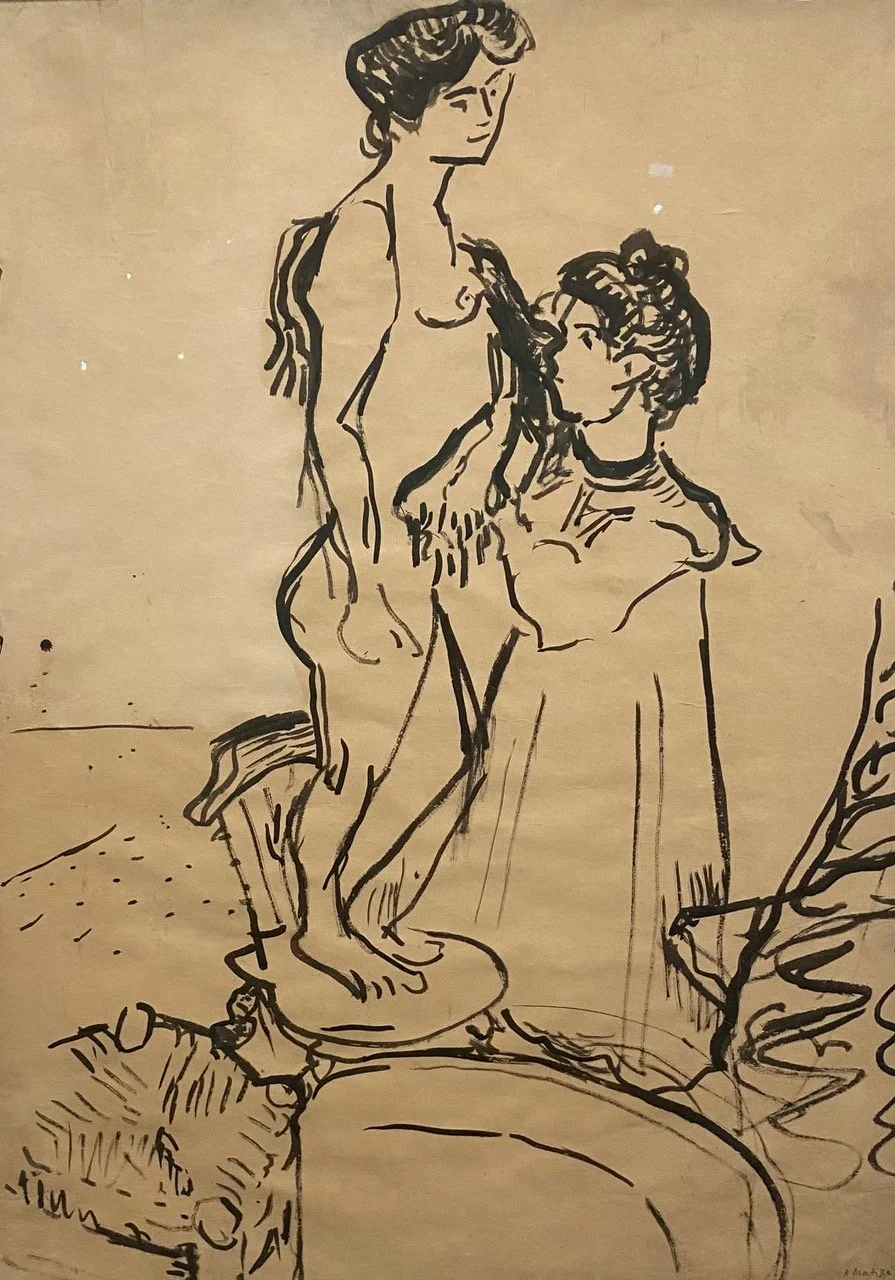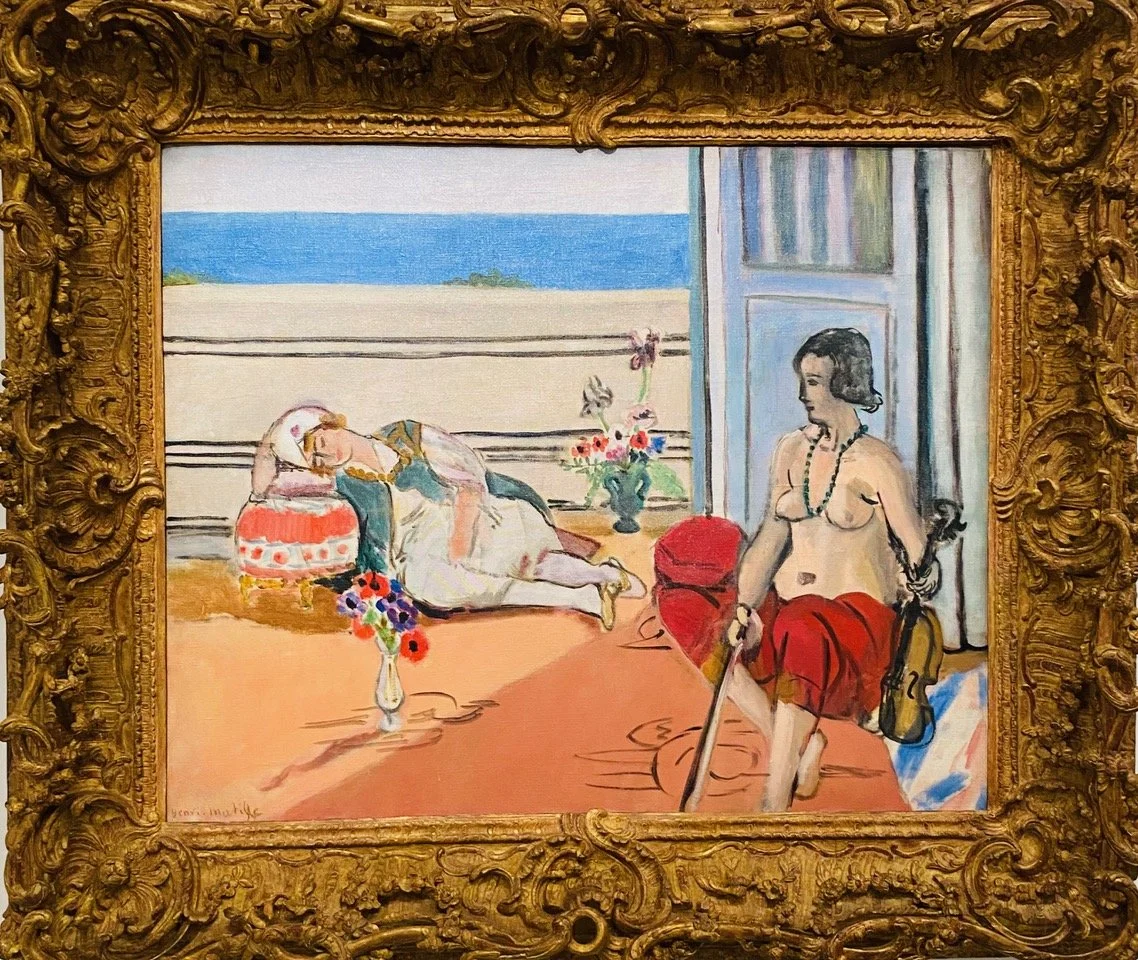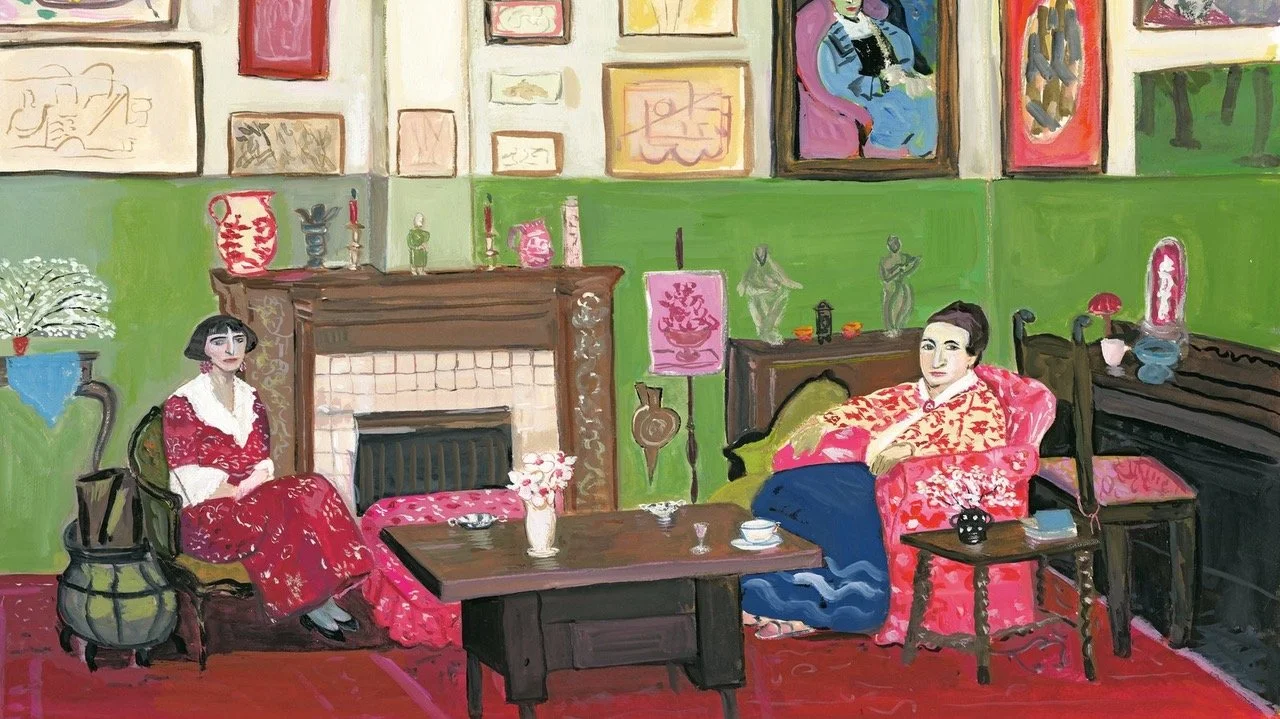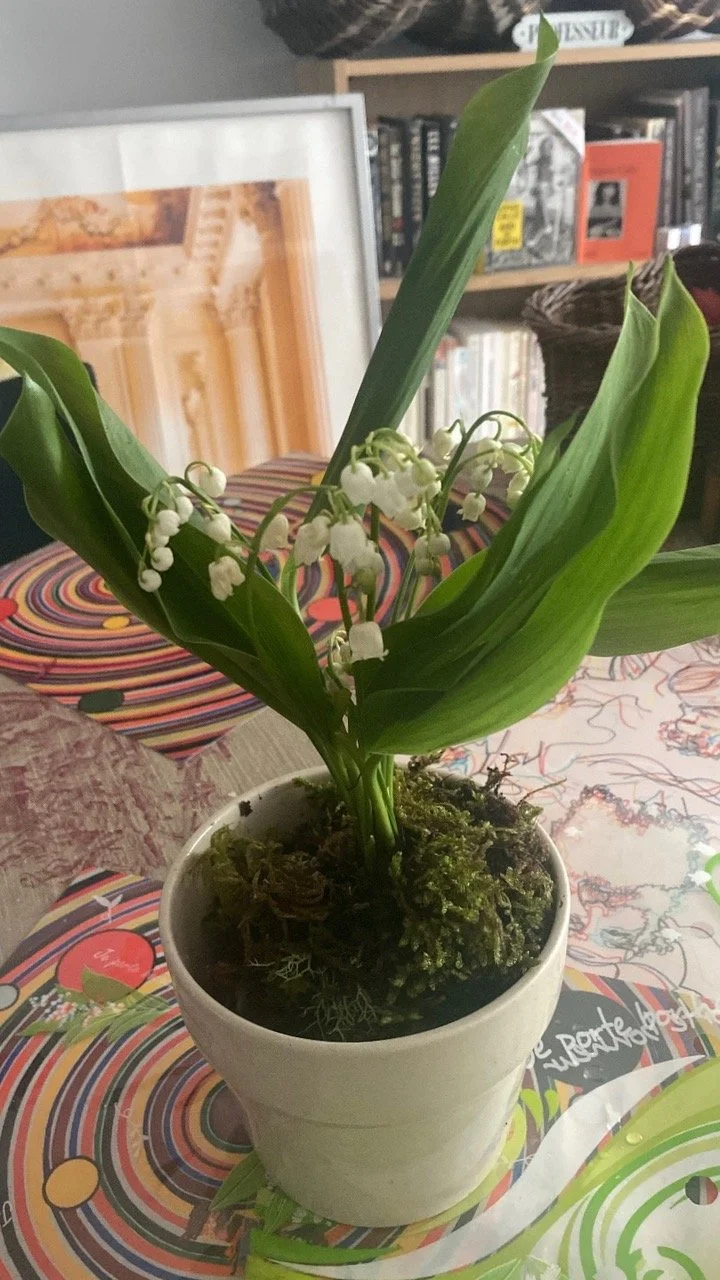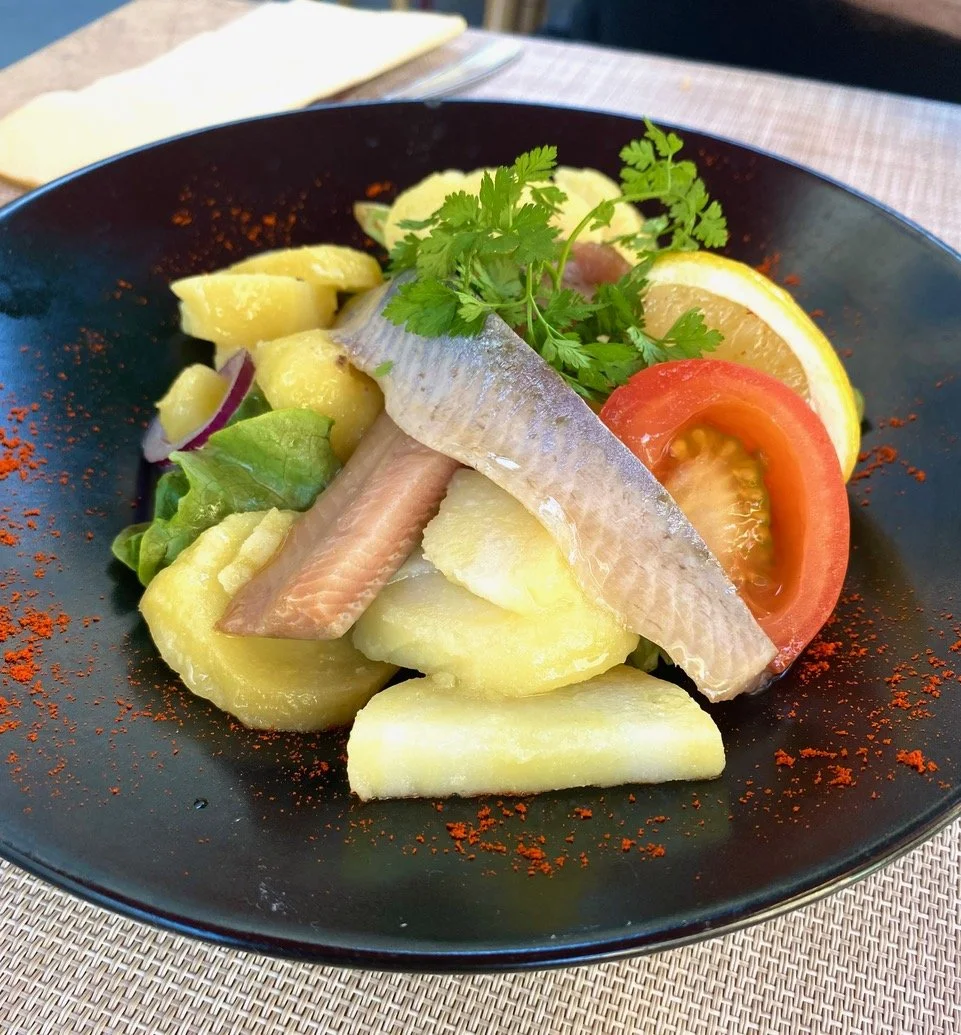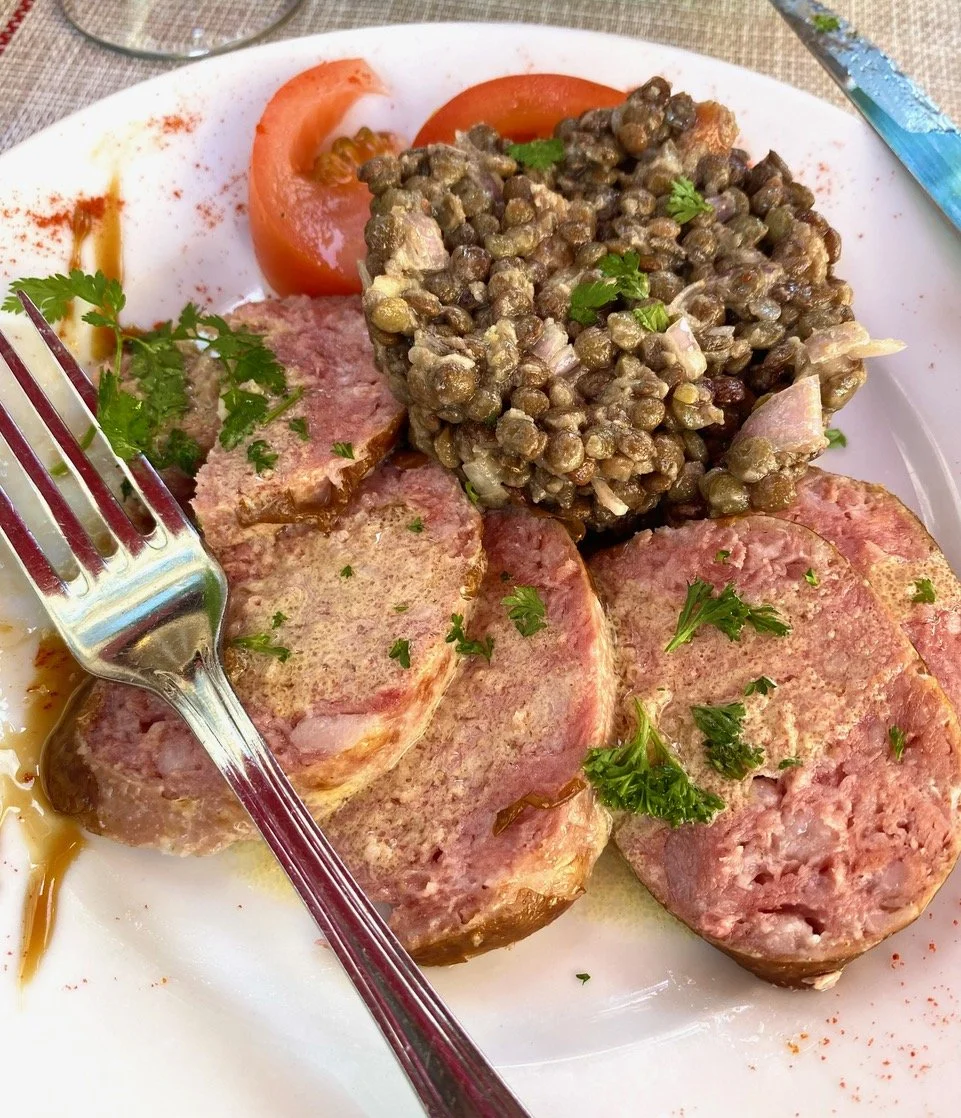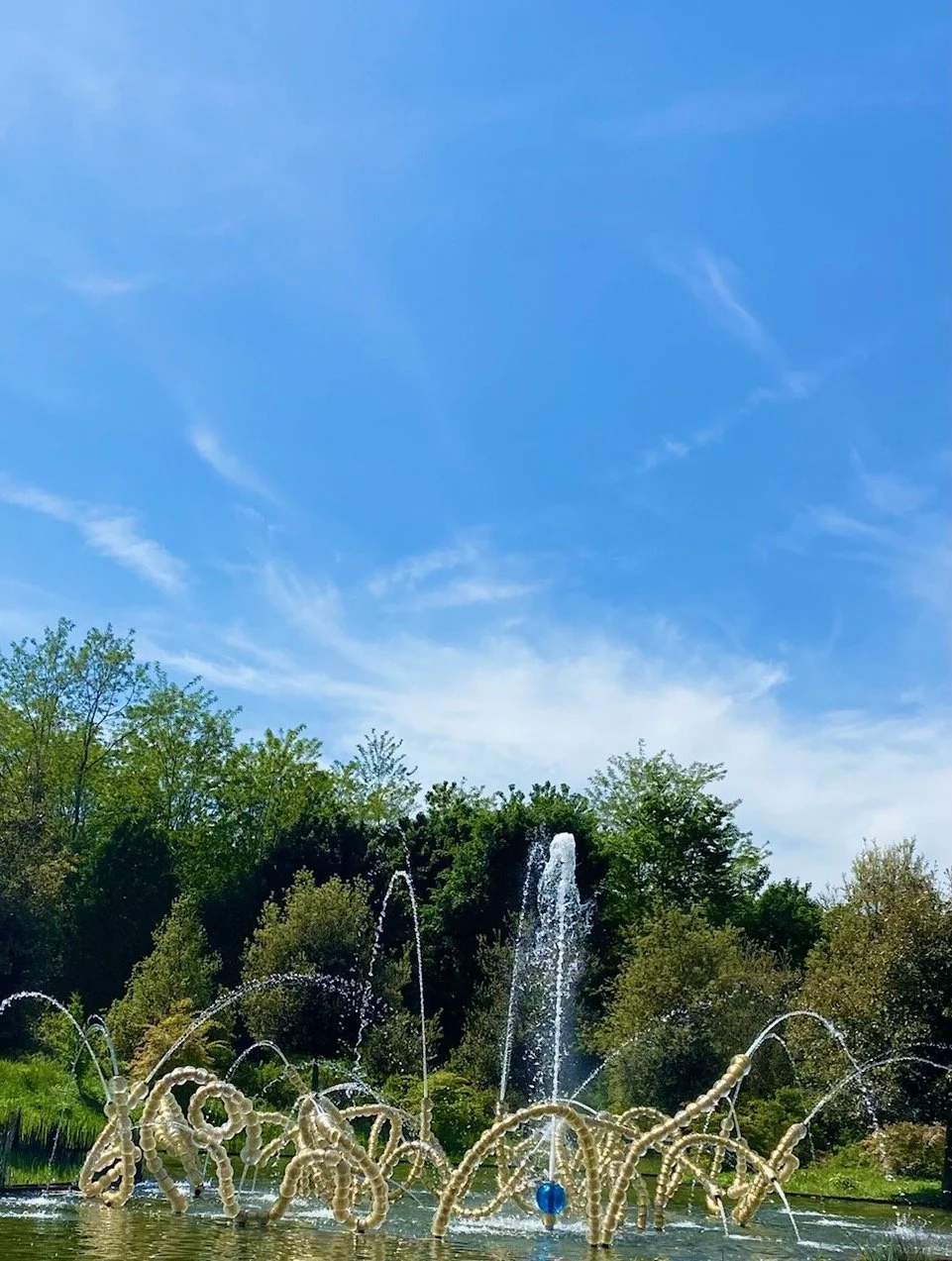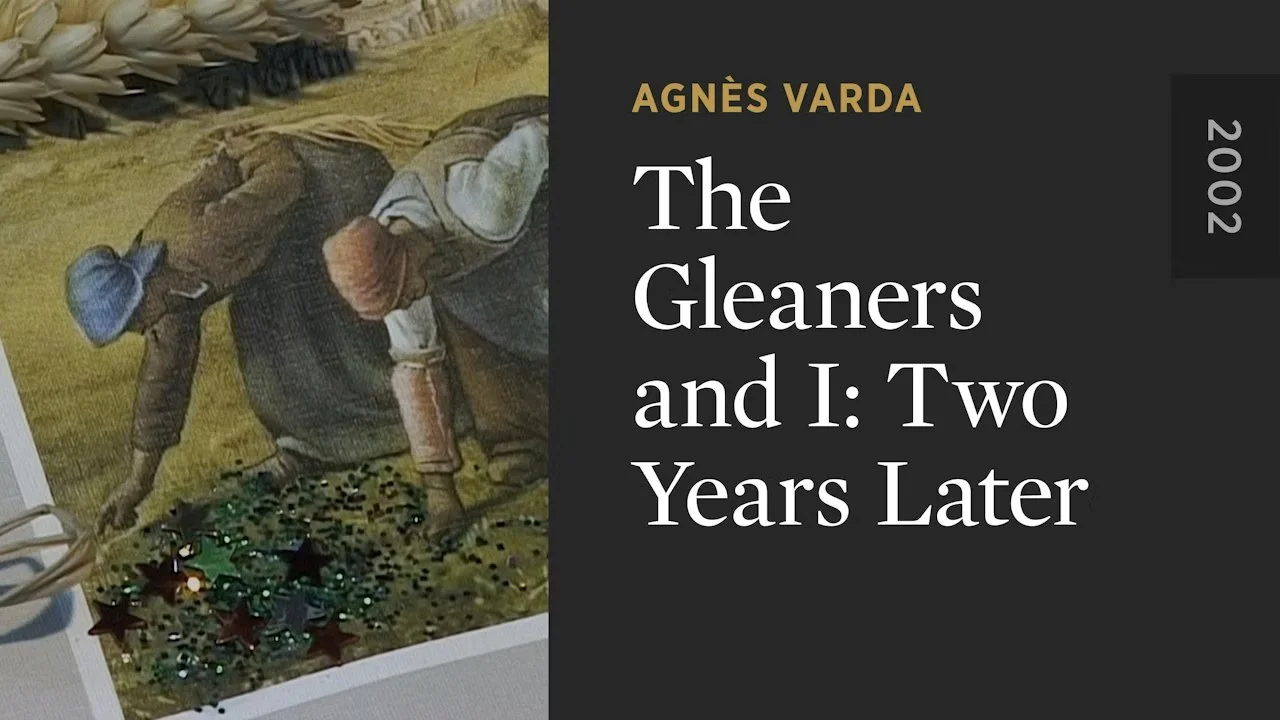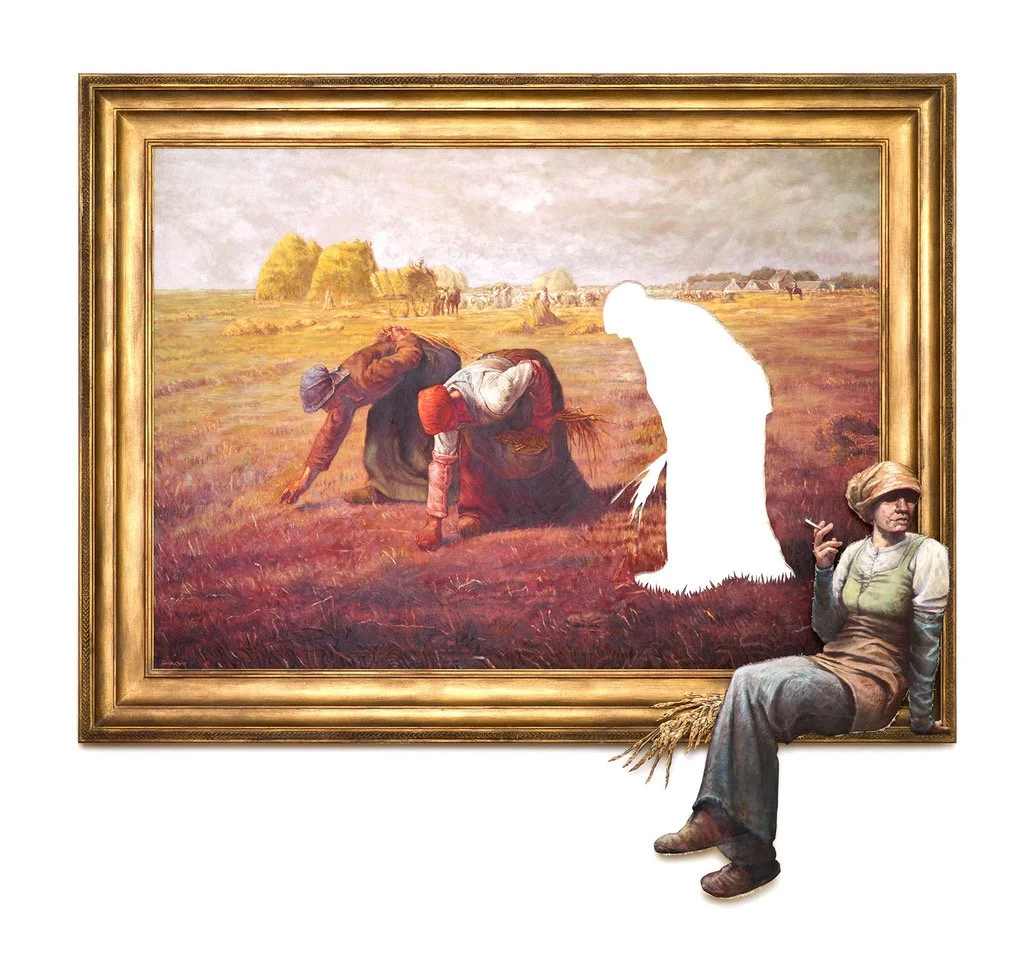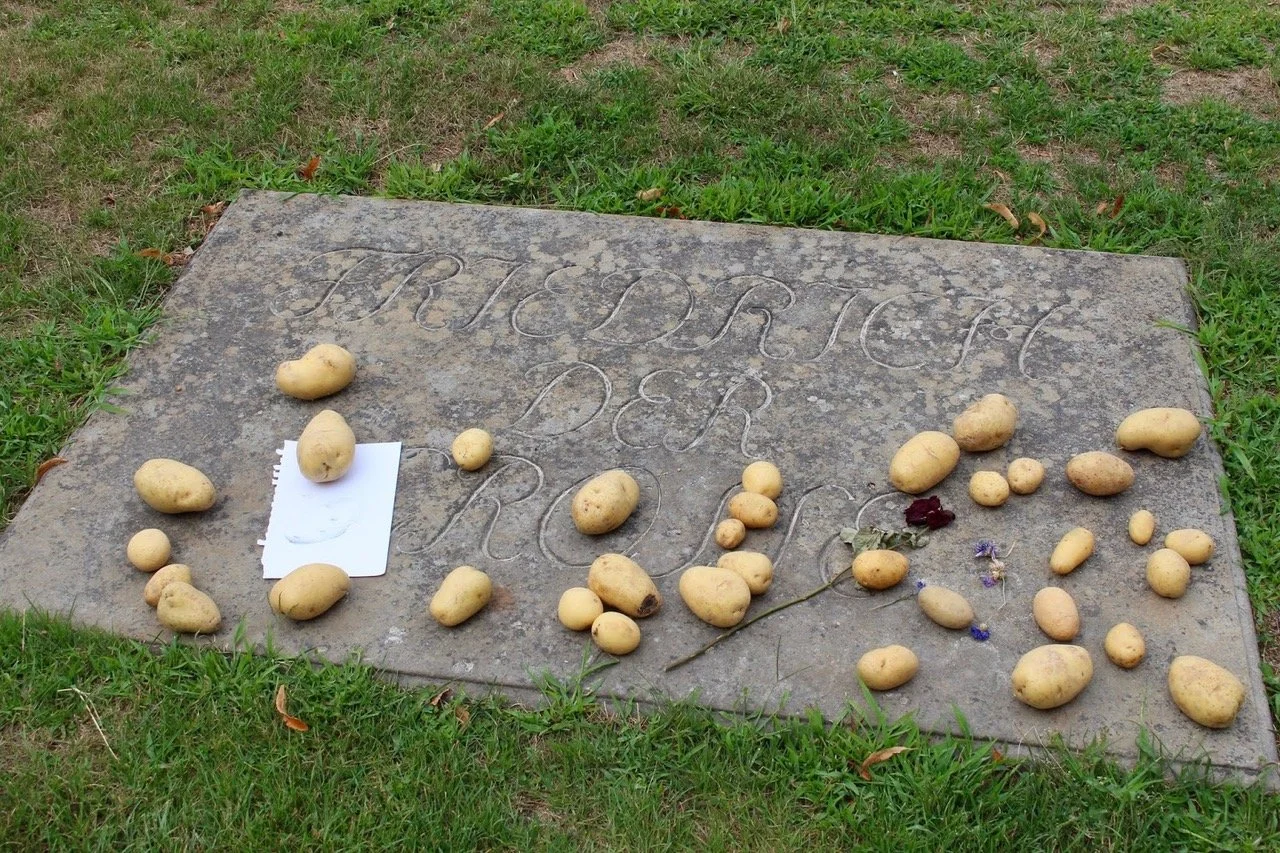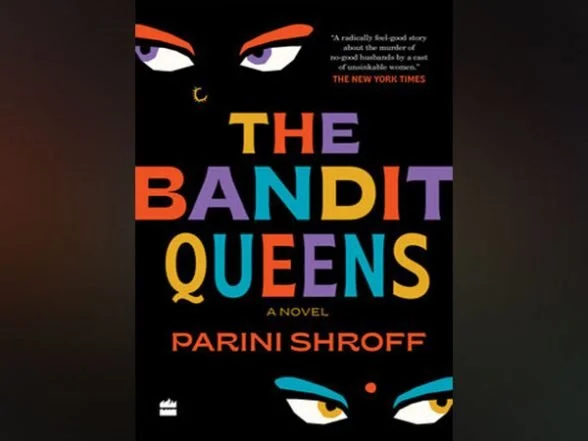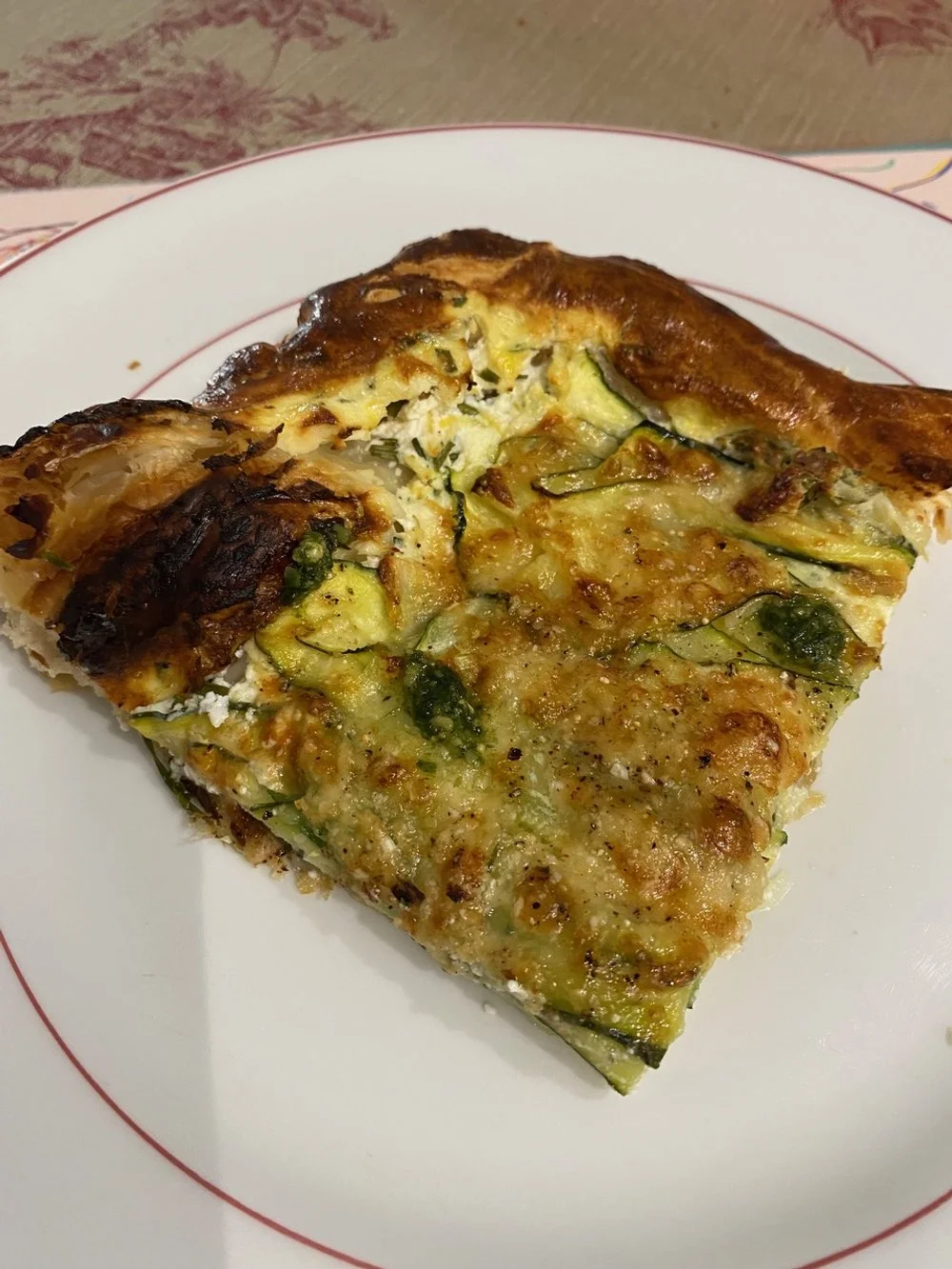The Merry Month of May
A feast for the eyes, the ears, the appetite Part 1.
Me doing graffiti with graffiti characters
Bienvenue and welcome back to Musée Musings, your idiosyncratic guide to Paris and art. As you probably expect, I see more exhibitions than I can tell you about. So today I want to mention a few of the ones I haven’t had time to discuss. I don’t know if this will surprise you, but I do not live exclusively in museums, I attend lectures, see films and read books (in addition to Proust). I want to tell you about of few of those, too. And since doing all this cultural stuff requires fuel (aka food), I want to share some of the recipes I have been trying with all the glorious fruits and vegetables I have been bringing home from the marché this month of May.
Since I’m writing this missive on the last day of May, I’ll begin with the last day of April. That evening I attended a talk given by Maira Kalman, whose New Yorker illustrations have always been among my favorites. The talk was held under the auspices of the American Library but it wasn’t held at the Library. It was at a venue new to me and happily near my apartment. It’s called the Maison de la Poésie and it’s in the Marais. The brainchild of the poet, resistance fighter and publisher, Pierre Seghers, he convinced his friend, who was then mayor of Paris, Jacques Chirac, to create it. Which he did in 1983.
Before the talk started, I chatted with the woman sitting next to me. I said that I wondered if Ms Kalman was going to talk about Gertrude Stein’s Nazi connections. The woman looked shocked and told me that she didn’t know what I was talking about. There was no need to convince her because we both had cell phones and all she had to do was Google it. And then for some reason (because we were both Americans?) we started talking about Elon Musk. She told me that Musk’s father had two children with a woman 40 years his junior. The age difference wasn’t the issue, it never is when the man is older. The issue was that the woman was his stepdaughter. He had married her mother when she was four. Very Woody Allen, except without the Mia Farrow tantrums.
Oddly enough, I had been thinking about Woody Allen’s photos of Soon Yi (that sent Mia Farrow over the bend) when I was writing about Henri Matisse and his daughter Marguerite. Specifically the 1911 painting The Large Nude, for which Blake Gopnik contends Marguerite posed. Nobody else has suggested that Marguerite posed for that painting or for any other painting nude. The evidence we have that Marguerite may not have been troubled by nudity is Matisse’s sketch of her holding a towel for a nude model and a painting in which she poses (next to? as?) a nude model. (Figs 1, 2)
Figure 1. Marguerite (with black ribbon around her neck) helping model get out of bath, sketch, Henri Matisse, 1905
Figure 2. Marguerite on poof and nude model OR model on poof and Marguerite nude, oil painting, Matisse, 1921
So, back to Kalman, the talk/conversation was lively and engaging. She showed us a snippet of a film she and her son wrote and in which played Alice. It was in conjunction with the illustrations she did for a new edition of the Autobiography of Alice B. Toklas, written by Gertrude Stein about herself. (Figs 3-5) Kalman did not mention that although many prominent Jews who thought they were safe, were rounded up and sent to the death camps, Gertrude and Alice, both Jews, were not deported. And that’s because Gertrude translated Nazi propaganda into English for a Nazi general (as I told the woman seated next to me). Although Kalman didn’t mention it in her talk, she did talk about it in an interview I read (NY Times, 2020). “Two gay Jewish women. I don’t know what other people need to do to survive — I can’t judge.” Tell that to Marguerite Matisse, resistance fighter, who was caught by the Gestapo, tortured for months and put on a train to a concentration camp. And she wasn’t Jewish, although her father benefited mightily from the patronage of Gertrude Stein’s brother and sister-in-law, Leo and Sarah.
Figure 3. Alice and Gertrude in their house, Maira Kalman illustration for The Autobiography of Alice B. Toklas written by Gertrude Stein
Figure 4 The cover portrait of Alice B. Toklas by Maira Kalman for The Autobiography of Alice B. Toklas by Gertrude Stein
Figure 5. Maira Kalman as Alice B Toklas, mustache part of costume
The day after Kalman’s talk was May 1, called by several names here in France - La Fête du Travail, La Fête du Muguet or just Premier Mai. There are two salient characteristics about the date. First, nearly everything is closed and even the places that aren’t, like my local grocery store, are open only briefly, like until noon. The second is that people who don’t have a license to sell anything are allowed to sell sprigs of lily of the valley that day. And they don’t have to pay taxes on whatever money they make. So it’s mostly benevol (volunteer) organizations that sell the sprigs. And people with a lily of the valley shrub in their backyard and some time on their hands. (Fig 6)
Figure 6. The Lily of the Valley sprig I brought home from Versailles
Since everybody was taking a day off, I decided to take a day off, too and go to Versailles. Which is so much easier now that I can use my metro card on the RER. And since January, the cost of a train ride to Versailles is the same as a metro ride in Paris. Once I arrived at the Versailles Rive Gauche train station, which, if you walk straight ahead, is a short stroll into the lovely little town of Versailles and if you turn right, is an equally short stroll to the Chateau, I chose town to find someplace simple for lunch. As it was a lovely spring day, my priority was a place with a terrace. The Bistro du Boucher fit the bill and the waiter wasn’t bothered when I ordered two entrées rather than an entrée and a plat. The herring and warm potatoes was okay but the slices of sausage with lentil salad, the day’s special was delicious and filling. (Figs 7, 8) I wasn’t tempted to look at the dessert menu because just around the corner from the bistro was Notre-Dame Market Hall. And that’s where San Luis Glacier, a Versailles institution since 1898, is located. They offer both traditional and original flavors - I enjoyed one of each -black sesame and coconut. (Figs 9, 9a) I’m not a fan of licking a cone as I walk, but taking dainty spoonfuls of ice cream from a cup, doesn’t seem as offensive, so that’s what I did as I made my way to the Chateau de Versailles. The chateau was closed, but the gardens were open and free and not too crowded. Here are a few of the things I saw: (Figs 10-13)
Figure 7. For the past few years, I’ve had this ’thing' for herring and warm boiled potatoes. This one was okay
Bistro du Boucher, Versailles
Figure 8. Slices of sausage and lentil salad was definitely delicious. Bistro du Boucher, Versailles
Figure 9. San Luis Glacier in the olde days
Figure 9a. My discreet dish of Black Sesame and Coconut ice cream
Figure 10. Chateau de Versailles, Grande Allée
Figure 11. A putto with a dove being watched over by actual mourning doves, Gardens of the Chateau de Versailles
Figure 12 Bosquet du Théâtre d’Eau, sculptures by Jean-Michel Othoniel, Gardens of Versailles
Figure 13 Bosquet du Théâtre d’Eau, sculptures by Jean-Michel Othoniel, Gardens of Versailles, detail
After writing about Agnès Varga whose work is the subject of an exhibition at the Carnavalet,(inspiration, creation and sharing) I was motivated to take a deep plunge into her filmography. I thoroughly recommend the 2017 documentary Varga made with JR called Faces/Places (Visages/Villages). There were a few cranky critics, one of whom reported that a young woman whose face was pasted onto a wall, which is what JR does - he makes everybody somebody worth noticing - felt uncomfortable with the celebrity - which btw is extremely short lived… but those critics were in the minority. Most everyone remarked upon the goodwill the artists demonstrated for each other and for the people they met and celebrated on their road trip. (Figs 14, 15)
Figure 14. Faces/Places (Visages Villages) Agnès Varda & JR, 2017
Figure 15. Faces/Places (Visages Villages) Agnès Varda & JR, 2017. An example of what JR does
Varga’s film, The Gleaners and I - (Les Glaneurs et La Glaneuse) and the follow-up film, The Gleaners and I: Two Years Later are fascinating.(Figs 16, 17) Both films are filled with historical, cultural, social and personal commentary. Scavenging from garbage bins or dumpster-diving is something most of us who live in urban areas have seen or pretended not to see as we walk along uncomfortably aware of people rifling through other people’s refuse, looking for a scrap of food or a cigaret butt.
Figure 16. Gleaners & I, Agnès Varda, 2000
Figure 17. Gleaners and I: Two Years Later, Agnès Varda, 2002
Turns out, gleaning has been around for a very long time. In the Old Testament, we read that one day the widow Ruth was gleaning in the fields of the wealthy farmer, Boaz. He saw her. He was attracted to her. And reader, he married her. (gleaning as an alternative to dating sites?) Ruth and Boaz are on the list of Old Testament begats. By which I mean that Ruth and Boaz begat Obed, who begat Jesse who begat David, the King of Israel and the ancestor of Jesus, according to the Gospels of Matthew and Luke.
In the middle ages, leaving crops for gleaners was part of European rural life. Because of gleaning, the right of usufruct was established. Do you know that word? I first came upon it when I began filling out forms for my little pigeonnier in the Dordogne. I understood that the forms were asking if I was living in a house that was not mine alone, if it was one that belonged to me and others who had inherited it and where I was permitted to live as long as I wished but which I understood was the property of all inheritors.
Usufruct started out with gleaning in mind. Usufructuary is the right to use and enjoy another person's property as long as the property is not destroyed, damaged or diminished. In nineteenth century France, usufruct rights, including the right to glean, were reduced or withdrawn, which provoked peasants to revolt, Balzac to write Les Paysans and Millet to paint The Gleaners. (Figs 18, 19)
Figure 18. The Gleaners, Jean-François Millet, 1857
Figure 19. Banksy’s riff on Millet’s The Gleaners, 2009
Waste was inherent in food production in the past and it’s worse now, and not just on huge, commercial farms. Even small farms, even organic ones committed to composting, waste food. Some waste is because of weather. Some waste is because a product doesn’t sell. And some waste is inherent in farming itself. And waste doesn’t end in the field, It happens in the warehouse, in the store, during transportation and at home. It has been estimated that as much as 40 percent of all cultivated food is never eaten.
At the end of the 20th century, in the United States, Congress and state legislatures passed Good Samaritan laws to protect growers who allow gleaning and gleaners who donate food to food banks, etc. The laws protect farmers from liability claims of gleaners who are injured in the fields and protect food donors from liability claims of recipients of donated food.
In France, gleaning is strictly regulated. In rural areas, fruits and vegetables can be collected only after they have been officially harvested. Only fruit that has fallen to the ground can be picked by a gleaner. In Paris, you can pick up fallen fruit in parks, public spaces or community gardens. A map called the Falling Fruit Map, available online, helps you locate gleaning sites everywhere in the world, even Paris.
As Agnès was gleaning, she kept digging up heart shaped potatoes in the field. She became, I guess you could say, obsessed with them, she brought them home with her where they happily (I guess) rotted on various shelves in her home/studio. (Figs 20-21) Since Agnès’ death, people paying their respects at her gravesite, have left heart shaped potatoes on her tombstone. It reminded me of watching people toss potatoes on the grave of the Prussian King, Frederick the Great at the Sanssouci Palace in Potsdam. That’s because he’s the one who allegedly introduced the potato to Prussia. (Fig 22)
Figure 20. One of the heart shaped potatoes Agnès found when she was gleaning in a potato field
Figure 21. A photograph Agnès took of one of the heart shaped potatoes she had gleaned and kept
Figure 22. Frederick the Great’s tombstone with potatoes, Sanssouci, Potsdam, Germany
Let’s see, what else. My Mystery Book Club is still on a roll. March was Peter Lovesey’s portly detective, Peter Diamond. April was Frances Brody’s splendid sleuth, Kate Shackleton. May’s selection was The Bandit Queens, (Fig 23) Parini Shroff’s debut novel, set in modern day India. Shroff has an MFA in writing, but she is hedging her bets, she also went to law school and is now an attorney as well as a published author!
Figure 23. The Bandit Queens, Parini Shroff
I knew I knew the name Bandit Queens as soon as I heard it but I couldn’t place it. Then I remembered a course Nicolas took in college on heroes and anti-heroes. One of the most improbable of the ones he studied was Phoolan Devi whose nickname was the Bandit Queen. (Fig 24) Her childhood was a horrific mix of poverty and sexual abuse. Her teens were a mix of retribution and incarceration. Her young adulthood started with an election and ended with an assassination (her own). During the retribution phase, the gang of which she was a member, robbed upper-caste villages and held up trains and trucks. While evading capture, Phoolan Devi was charged in absentia for the 1981 massacre of 20 upper class men, allegedly killed at her command. By punishing the men who raped her and by evading capture, she became a heroine to India’s poor - a female Robin Hood. She served 9 years in jail for the murders and when she was released, she was elected to Parliament. She didn’t make it to her 38th birthday. (Fig 24)
Figure 24. Phoolan Devi
That’s the badass heroine whose name is evoked often and with admiration by the women who form this book’s cast/e of characters. They have known each other since childhood but they come together weekly now because of their micro-loan meetings.The novel was inspired by a micro-loan meeting the author attended. During which she asked two questions: Why were the loans only offered to women and what would happen if a husband stole his wife’s loan money. The first question has been asked and answered often. Women are dependable. If they accept a loan, they accept the principle that it has to be repaid. Men are not dependable and they don’t honor their debts.
The second question formed the genesis of this book which is set in contemporary rural India, where women’s lives are mostly awful because of the awful men they were forced to marry. Because the men are mostly drunks who spend whatever money they or their wives make on alcohol which makes them even more belligerent and violent.
Here’s the book’s central premise: - is it possible for abused women to get rid of their abusive husbands? The heroine of the story, Geeta lives alone. Because she has no children and her husband has disappeared. It’s generally assumed that she killed him and disposed of his body. Even though she didn’t, she sees no reason to plead her innocence. She likes being left alone and people do tend to leave assumed killers alone. Except that the other women in her micro-loan group want her help in getting rid of their husbands.
There are some murders in this book, after all, I did read it in conjunction with my monthly mystery book club, but they definitely seem justified - I mean those husbands really are awful and those women really do need to get rid of them ….. The writing is so good and so contemporary that I found myself laughing out loud as I marveled at the plot twists and luxuriated in the language. My only regret is that I didn’t read the book more slowly. I’ll definitely be reading it again, next time for the pleasure of the words.
And finally, the marché has been overflowing with green things - haricots vert, asperges, petits pois, courgettes and mange-tout. A Melissa Clark recipe for Pasta Primavera proved a wonderful way to use the asperges, petit pois and mange-tout. A recipe by Ali Slaegel resulted in a delicious pairing of haricots vert, cornichons, cornichon brine and feta cheese. Ginevra sent me a recipe from @juliusroberts for a zucchini tart. I had never made a tart before because I have never wanted to try making puff pastry. But here in France, nobody makes puff pastry, everybody buys it raw, refrigerated, ready to go. The tart came together faster than writing my shopping list did - and there are very few ingredients in this tart. It looked good and it was delicious. (Figs 25-27) Lots of fruits and vegetables are seasonal but nothing I think is more seasonal than rhubarb. I have been making Samantha Seneviratne’s rhubarb quick bread and Mark Bittman’s rhubarb crumble and Mellisa Clark’s oat cakes with roasted rhubarb on rotation. (Figs. 28-30) Yes, I’m obsessed!
Figure 25. Melissa Clark’s Pasta Primavera with petit pois, mange-tout and asperge, (for the New York Times)
Figure 26. Ali Slaegel’s haricots vert, cornichons, onions & feta (for the New York Times)
Figure 27. Julius Roberts Courgettes Tart with ricotta and parmesan cheeses, @juliusroberts
Figure 28. Samantha Seneviratne’s Rhubarb Quick Bread, (for the New York Times)
Figure 29. Mark Bittman’s Rhubarb Crisp, (for The New York Times)
Figure 30. Melissa Clark’s Oatcakes and Roasted Rhubarb, (for The New York Times). She says to cut the dough into 6, I cut it into 12. In a pinch you can pretend you are eating a hearty scone (I do) and serve it with butter and jam.(I do)
Next week I’ll tell you about the temporary exhibitions I mentioned earlier and my visit (finally) to reopened and squeaky clean, Notre Dame as well as a few restaurants I tried recently. Gros bisous, Dr. B.
Thanks to those of you who wrote Comments about Artemisia Gentileschi. They are much appreciated.
New comment on Revenge may be Sweet but Success is Sweeter:
One of my favorite artists. I first saw her paintings in Rome, perhaps in the Barberini. Then I read and wrote about her https://garyjkirkpatrick.com/artemesia-gentileschi-one-of-few-women-painters-in-the-1600s/ The stuff women are subjected to! Your insights are much appreciated. Gary Kirkpatrick
Hi Beverly, I just read a Veronica Speedwell book (A Perilous Undertaking), in which the victim is an artist named Artemesia, so I found your latest email came with perfect timing. Maureen, Paris
A lovely essay, thank you. I came across her in the time-travel series 1632, in which a small US town is somehow transplanted into Germany in the 30 years war, and great fun it is, and it went on for several more entertaining novels, in one of which we have the famed woman artists, Best wishes from Austria, on book tour, Martin Walker, Dordogne

